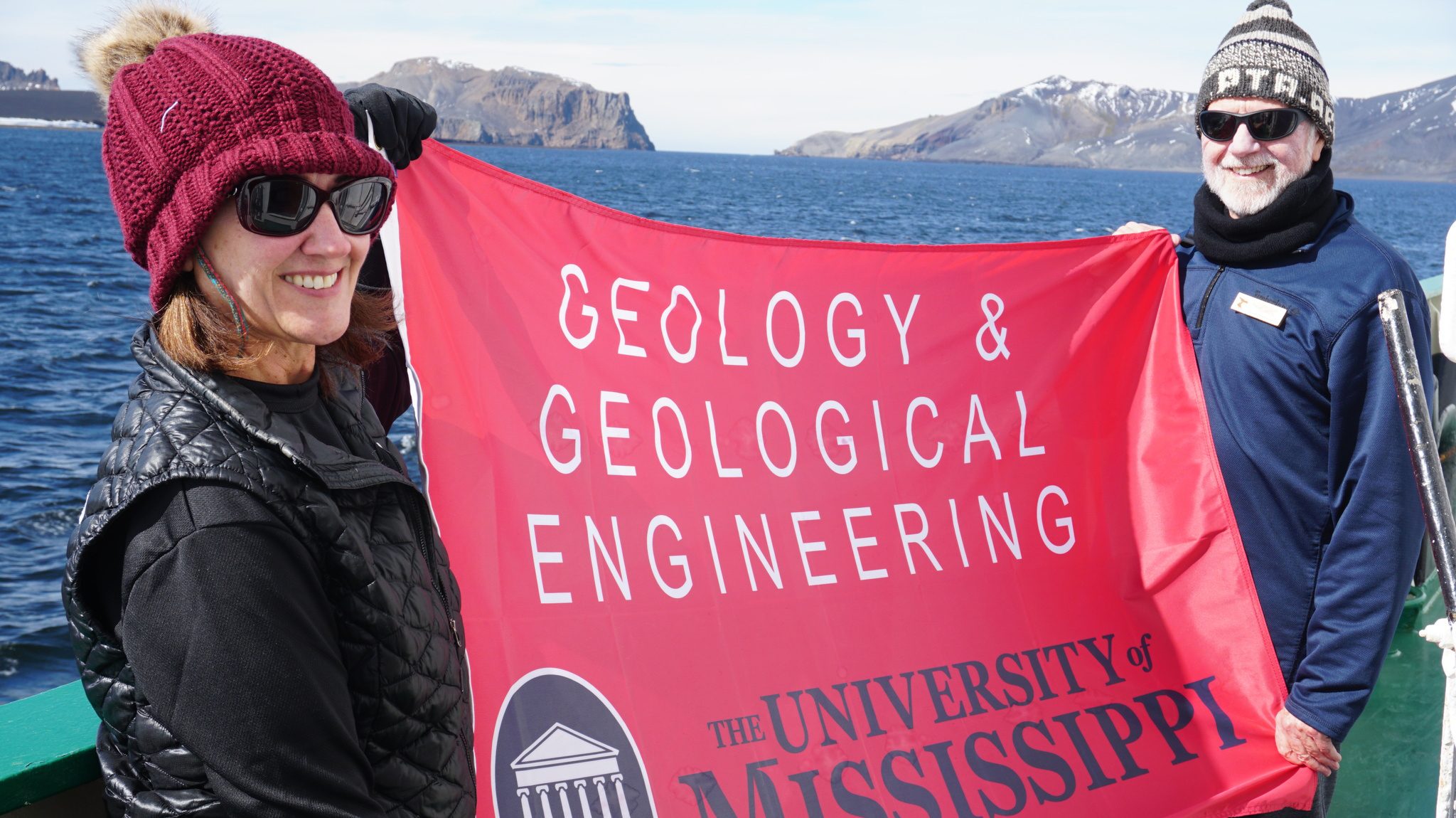
UM geological engineering alumnus Stephen Franks and his wife, Kaye, give a shoutout to his alma mater during a recent visit to Antarctica. Submitted photo
Stephen Franks is living his dream, traveling the globe while enjoying his career as a professional geologist.
The University of Mississippi alumnus, who received a master’s degree in geology in 1970, and his wife, Kaye, have visited all seven continents, most recently having completed a “bucket list” trip to Antarctica. Franks spent 18 days in Antarctica visiting geological sites, photographing whale flukes to help identify individual whales and tracking their movement, and collecting phytoplankton to assist a Scripps Institution of Oceanography study of the effects of freshwater from glacial melting on the marine ecosystem.
“Being a geologist has not only provided me with a good living, it opened the world to me,” said Franks, a Mississippi native, who also holds a bachelor’s degree in geology from Millsaps College and doctoral degree in geology from Case Western Reserve University.
A former research geologist with Atlantic Richfield Corp. in Dallas, Texas, and later with Saudi Aramco’s Advanced Research Center in Dhahran, Saudi Arabia, Franks is president of RockFluid Systems Inc. of McKinney, Texas.
“I have worked in countries I would have never seen were I not a geologist,” Franks said. “We even have a home in Bodrum, on the coast of Turkey, a country I would never have visited except for my work. Best of all, I looked forward to going to work every day.”
Reflecting on his time in Antarctica, Franks found it difficult to single out the most fascinating aspect of the trip.
“The wildlife (whales, seals, penguins) was amazing, but I think the one thing that I never tired of seeing was the icebergs and glaciers,” he said. “The icebergs just have an incredible range of colors, from pure white to deep blue to crystal clear. They come in all different sizes, of course, but the immensity of some of them just boggles the mind when you think that most of their mass is beneath the water.”
Franks has studied ancient glacial deposits in Oman, deep-sea turbidites in the Aleutians, volcanic rocks in Newfoundland and modern and ancient desert deposits in Saudi Arabia.
“When we were living in Saudi Arabia, Kaye and I had friends who had taken an ecotourism cruise to Antarctica in a small group,” Franks said. “They recommended the group that we toured with — an ecotourism, citizen-science tour that emphasized maximum time onshore and participation in various projects.”
The trip was not a typical cruise ship tour, Franks said.
“We were aboard a retired Russian spy ship with an all-Russian crew chartered by the tour company,” he said. “Accommodations were simple but very comfortable, food was very good and the group (fewer than 100 people) quite small. Almost all our shipmates were serious-to-professional photographers, marine biologists, naturalists and even one other geologist.”
Geologically, the most interesting experience was sailing into the crater of an active volcano (Deception Island) and seeing steam rising from the ocean from the volcanic heat, Franks said.
“I love being outside, studying rocks in the field and trying to imagine how they were deposited,” he said. “I also love looking at rocks under the microscope, whether it be an optical petrographic microscope or a scanning electron microscope. The details of rocks can tell us their history, their origin, the pressures and temperatures they have experienced and their potential to produce oil and gas.”
During his tenure as an Ole Miss graduate student in the early ’70s, Franks remembers the late Velon Minshew and Bill Reynolds as having been his favorite geological engineering professors. A graduate of Ohio State University’s Polar Research Institute, Minshew’s field area was Antarctica.
“He brought such enthusiasm and excitement to the classroom,” Franks said. “He further encouraged my love of petrography by using his collection of Antarctic samples in our classes. The volcanic and sedimentary rocks from such an exotic location fascinated me.”
Continental drift and plate tectonics were hotly debated theories when Minshew managed to have J. Tuzo Wilson (a famous advocate of plate tectonics) visit the geology and geological engineering department.
“Dr. Wilson was in great demand for speaking engagements at this time, so this was a big deal for us students and the department,” Franks said. “His presentation inspired us.”
A clay mineralogist whose research interest was the origin of the enigmatic Tallahatta Formation of Mississippi and Alabama, Reynolds became Franks’ thesis adviser. Both Minshew and Reynolds spent time with Franks in the field, helping him to understand field relations and asking him probing questions.
“There is no question that the time they spent with me was instrumental in my desire to continue my geological education and pursue a Ph.D.,” Franks said. “Everything that followed would not have been possible except for them and my time at Ole Miss.”
Marni Kendricks, assistant dean for undergraduate academics in the School of Engineering, said Franks is an exemplary alumnus.
“Dr. Franks excelled as a master’s student, pursued and enjoyed an impressive career path and became a successful entrepreneur,” she said. “We appreciate his willingness to acknowledge the importance of his alma mater.”
For a video of photos taken by Franks while in Antarctica, click here.